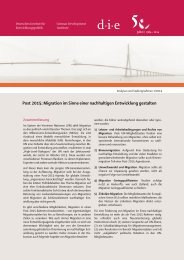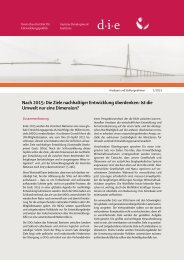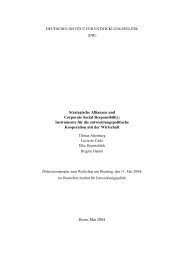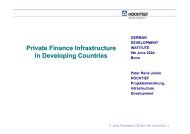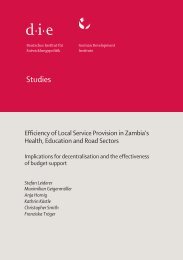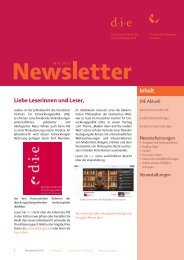Middle East / North Africa and the Millennium Development Goals ...
Middle East / North Africa and the Millennium Development Goals ...
Middle East / North Africa and the Millennium Development Goals ...
Create successful ePaper yourself
Turn your PDF publications into a flip-book with our unique Google optimized e-Paper software.
<strong>Middle</strong> <strong>East</strong> / <strong>North</strong> <strong>Africa</strong> <strong>and</strong> <strong>the</strong> <strong>Millennium</strong> <strong>Development</strong> <strong>Goals</strong><br />
Labor-force participation <strong>and</strong> income<br />
The main problem facing <strong>the</strong> region is that <strong>the</strong> improvements that have<br />
been reached on women’s education <strong>and</strong> health have not yet found expression<br />
in improved opportunities for employment, income, <strong>and</strong> labour-force<br />
participation of women (UNDP / AFESD 2002, 28); Weiss 2004b, 8 f.;<br />
World Bank 2004 f.).<br />
The average labor-force participation rate of women in <strong>the</strong> MENA countries<br />
is lower than <strong>the</strong> respective rate of all o<strong>the</strong>r world regions, <strong>and</strong> it is<br />
also far below <strong>the</strong> level that would be expected in view of <strong>the</strong> literacy<br />
rates, life expectancy, <strong>and</strong> fertility rates of women in <strong>the</strong> region. Figure 6<br />
clearly illustrates this. According to <strong>the</strong>se data, <strong>the</strong> labor-force participation<br />
rate of women in sub-Saharan <strong>Africa</strong> is roughly as low as in <strong>the</strong><br />
MENA region. However, <strong>the</strong> diagram shows only <strong>the</strong> proportion of<br />
women working outside agriculture. In sub-Saharan <strong>Africa</strong>, a larger percentage<br />
of women (<strong>and</strong> men) are employed in <strong>the</strong> agricultural sector. As a<br />
consequence, on <strong>the</strong> whole, <strong>the</strong> labor-force participation of women in <strong>the</strong><br />
MENA region is roughly 30 %, while <strong>the</strong> corresponding figures for Latin<br />
America (45 %), sub-Saharan <strong>Africa</strong> <strong>and</strong> <strong>East</strong>ern Europe <strong>and</strong> Central Asia<br />
(60 %), <strong>and</strong> <strong>the</strong> Pacific region (75 %) are far higher (ESCWA 2005; World<br />
Bank 2004 f.).<br />
Figure 6 fur<strong>the</strong>rmore shows that <strong>the</strong> employment chances of women in <strong>the</strong><br />
MENA region have even deteriorated since 1990. Only in Algeria, Oman,<br />
<strong>and</strong> Bahrain has <strong>the</strong> percentage of women among all nonagricultural<br />
workers risen, while it has declined in Yemen (from 9 to 7 %), Jordan<br />
(from 23 to 21 %), Saudi Arabia (from 19 to 14 %), <strong>and</strong> Morocco (from<br />
37 to 27 %). The same is probably true for Kuwait <strong>and</strong> Mauritania, where<br />
<strong>the</strong> labor-force participation rate of women has declined markedly since<br />
1990 (see Table A5, Annex).<br />
Moreover, on average women engaged in gainful employment in <strong>the</strong><br />
MENA region earn lower incomes than men (Salehi-Isfahani 2000; World<br />
Bank 2004 f.). Palestinian women are in a relatively good position in this<br />
regard; on average <strong>the</strong>y earn 73 % of <strong>the</strong>ir male colleagues. At <strong>the</strong> same<br />
time, <strong>the</strong> situation in Saudi Arabia <strong>and</strong> Oman is especially bad, with<br />
women earning wages <strong>and</strong> salaries that amount not even to one quarter of<br />
<strong>the</strong> average earnings of men (see Figure 7 <strong>and</strong> Table Table A5, Annex).<br />
German <strong>Development</strong> Institute 59



